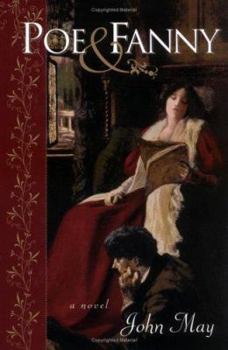Poe & Fanny
Select Format
Select Condition 
Book Overview
In 1845, Edgar Allan Poe, published his acclaimed poem "The Raven," became the overnight darling of New York literary society, and fell in love with a beautiful and equally famous poet. It was the year that ruined him forever. John May's perfectly imagined novel brings New York's giddy pre-Civil War social scene into brilliant focus as it unfolds the spellbinding story of a doomed man and the great love that sealed his fate. By the end of what should have been his crowning year, Edgar Poe was reviled by the same capricious circles that had gathered adoringly at his feet to hear him recite "The Raven" again and again. Swept up in the fervor, Frances Sargent Osgood, then separated from her husband, arranged an introduction to Poe to offer her fealty and her friendship. But what eventually transpired between them was far more than two poets' mutual admiration. Over the course of their brief liaison, the two lovers wrote and published (under pseudonyms) many not-so-veiled love poems, and soon enough, New York's literati were abuzz with their affair. While Poe dallied, his dying wife, Sissy, and her mother were humiliated. And while he despaired, drinking himself into oblivion, Poe's dream of editing his own magazine in New York died on the vine. At the turn of the year, the Poes left New York in disgrace. Deeply in debt and spurned by former fawning admirers, including Horace Greeley, N.P. Willis, William Cullen Bryant, Richard Henry Dana, and Maria Child, American's most renowned writer was a broken man. He had wrecked two women's lives. Even so, both Fanny and Sissy loved him unremittingly to the bitter end. Poe died at the age of forty, alone and having never fathered a child. Or had he? Told with special empathy for Fanny's warm, impulsive generosity as it shimmered alongside Poe's dark genius, "Poe & Fanny" follows the lovers' story to its logical conclusion: Fanny Osgood's third child was Edgar Allan Poe's. John May brings to life the drama of these lives acted out against the backdrop of nineteenth century New York's vibrant literary world. "
Format:Hardcover
Language:English
ISBN:1565124278
ISBN13:9781565124271
Release Date:January 2004
Publisher:Algonquin Books of Chapel Hill
Length:323 Pages
Weight:1.25 lbs.
Dimensions:1.2" x 6.3" x 9.1"
Customer Reviews
4 ratings
Slow reading but captivating
Published by Thriftbooks.com User , 19 years ago
For some reason it took me much longer than usual to read this book. Maybe it was the detail. However, I really wanted to know how the story evolved and ultimately ended. A fascinating and captivating story which is written from the revolving points of view of the main characters. I didn't find out until the end of the book that most of the poems referenced or excerpted were in the back of the book. This would have been good to know so I could have read them as they took place in the storyline. Some imporatant points or references to Poe's life could have been better clarified or discussed in the storyline. They were simply passed over or given passing reference. But I came away thirsting for more on Poe. I also advise you to keep a copy of "The Raven" handy since it is pivitol to the story and not reprinted. You will want to re-read it! I've visited his grave often since I live in Baltimore, and attended law school here where he rests (at Westminster Hall's graveyard attached to the school). Now I really understand better some of the main events in his life and his downfall. I recommended the book.
Page turner
Published by Thriftbooks.com User , 20 years ago
John May's first novel left me with great hope that he will write more. Poe & Fanny was a wonderful education in the state of the literary world, and life in general, in the 1840's as well as a fascinating look at Poe himself. Most people grow up reading The House of Usher, The Tell-Tale Heart, and The Raven in school with only enough information about him to know he had a way with the macabre and married his first cousin. This book revealed the very vulnerable, tender, human side of this incredibly talented man who, like a lot of artists, had all the talent and the heart to succeed but couldn't get it together. The daily drama of his life combined with the passion he felt for Fanny --and John May's wit and talent - made this a book I could not put down.
Why We Read Historical Fiction
Published by Thriftbooks.com User , 21 years ago
Baltimore's original Raven fans could not be more compellingly imagined. This romantic and richly detailed story of Poe's struggles with alcohol, ambition, creativity, loyalty, and multiple loves not only introduces readers to the wrongly forgotten poet Frances Osgood, but also brilliantly illuminates 19th-century American culture, especially the competitive world of New York City publishing. The writing is fresh. The scandal is new. The book is terrific.
Intriguing!
Published by Thriftbooks.com User , 21 years ago
I was so taken by the world of this book-- the hustling and rivalry of the various magazine editors of the time, the heated, gossipy atmosphere of the literary salons-- all fascinating. And Poe himself emerges as an intriguing character. Despite the fact that he's one of the pillars of American literature, Poe & Fanny shows his all-too human sides as well as his constant struggles for both financial solidity and literary reputation. And I was torn as a reader between Poe's love for his sickly young wife and his soulmate-like passion for Fanny! The pages flew by as I was drawn into the author's delicate resolution of the story.





